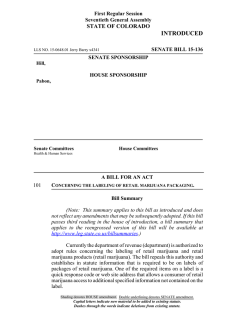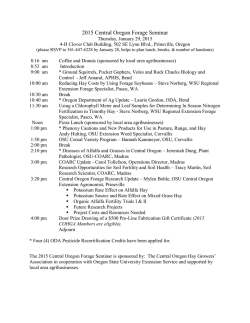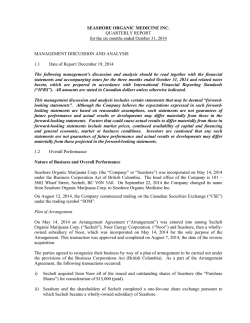
OREGON`S MARIJUANA FUTURE - Portland State University
OREGON’S MARIJUANA FUTURE A. SYNKAI HARRISON & CARLY HARRISON Portland State University When imagining the future legalization of marijuana in Oregon, it may be difficult to have a clear picture. Objections circulate, apocalyptic images abound, and Oregon is left with many questions marks. However, with Colorado and Washington going before us to legalize and regulate the recreational use of the Schedule 1 drug in 2014, Oregon can look to recent history and the current reality of these other pioneering states as we discover how to implement Measure 91. ■ A. Synkai Harrison is a Master of Real Estate Development candidate and has been awarded the Center for Real Estate Fellowship. Carly Harrison is a Master of Real Estate Development candidate and has been awarded the Center for Real Estate Fellowship. Any errors or omissions are the author’s responsibility. Any opinions are those of the authors solely and do not represent the opinions of any other person or entity. Center for Real Estate Quarterly Report, vol. 9, no. 1. Winter 2015 5 MARIJUANA IN OREGON HARRISON & HARRISON 6 A SHIFT IN OPINION US Cannabis Laws Jurisdiction with legalized cannabis. Jurisdiction with both medical and decriminalization laws. * Jurisdiction with legal psychoactive medical cannabis. Jurisdiction with legal non-psychoactive medical cannabis Jurisdiction with decriminalized cannabis The journey to legalize marijuana has possession laws. been swift and has had some surprisJurisdiction with total cannabis prohibition ing momentum. In 2006, only 32 perSource: Wikimedia Commons cent of Americans said they favored legalizing across the country, while the number has jumped to 53 percent today according to a Pew Research Center poll.1 In the last two years, recreational marijuana is new to four states (Alaska, Washington, Oregon and Colorado) and Washington D.C., yet 22 additional states have already had legislation that allows for (1) medical marijuana and decriminalization (10 states), (2) medical marijuana (8 states), or (3) decriminalized only (4 states). As many as five states could legalize recreational marijuana in 2016. Nevada, California, Maine, Arizona and Massachusetts are expected to have legalization legislation on the ballot.2 Florida nearly legalized medical marijuana in 2014, being approved by 58 percent of the electorate, where state ballot initiatives need 60 percent of the vote for approval. If passed, this would represent a huge shift in the national landscape of marijuana, especially given that the large market and economy of California is among them. OREGON’S JOURNEY Oregon has long been on the path to legalized marijuana. Oregon decriminalized marijuana use in 1973, and in 1998 passed Measure 67, which legalized medical marijuana. In 2014, Oregon voters made it legal for adults over the age of 21 to possess, use and cultivate marijuana by approving the “Control, Regulation, and Taxation of Marijuana and Industrial Hemp Act” or as it is commonly known, Measure 91 by a vote of 57 percent. 1 In Debate Over Legalizing Marijuana, Disagreement Over Drug's Dangers. Pew Research Center for the People and the Press RSS, April 24, 2015. Retrieved April 30, 2015 from http://www.people-press.org/2015/04/14/in-debate-over-legalizing-marijuana-disagreementover-drugs-dangers/ 2 Steinmetz, K. These five states could legalize marijuana in 2016. Time, March 17, 2015. Retrieved May 22, 2015 from http://time.com/3748075/marijuana-legalization-2016/. MARIJUANA IN OREGON HARRISON & HARRISON 7 The measure does not amend or affect the Oregon Medical Marijuana Act, which maintains its jurisdiction over the medical market, but outlines the structure of the recreational market, directing the Oregon Liquor and Control Commission (OLCC) to establish, regulate, and license marijuana businesses. This means that effective July 1, 2015, a person is able to possess up to eight ounces and households can grow no more than four plants—provided the plants are not visible. The measure also imposes limits on liquid and other forms of marijuana.3 While possession up to these limits will be legal, marijuana may only be legally consumed in private residence, meaning that public consumption will still be illegal and enforced. FEDERALLY ILLEGAL However, despite the citizens of Oregon choosing to make recreational marijuana legal, it still considered a Schedule 1 controlled substance by the federal government. The Controlled Substance Act (CSA), signed into law by President Nixon, places drugs into classifications or schedules which are based on their potential for abuse, medical benefits and their statuses in international treaties. Over 160 different drugs have been added, removed or reclassified since the act was signed into law, but marijuana remains a Schedule 1 drug, which is considered to have no accepted medical use.4 To provide guidance to federal prosecutors, the federal government issued what is referred to as the “Cole Memo.” Since then, states have used the memo for guidance. In 2013, Deputy Attorney General James Cole released a memorandum providing guidance to US Attorneys on marijuana enforcement under the Controlled Substance Act. The memo affirms that according to the Federal government, marijuana is a dangerous drug and that its sale and distribution provide a source of revenue to large-scale criminal enterprises. However, the memo lists the eight enforcement priorities of the Department of Justice such as distribution to minors, revenue to cartels, violence, and drugs and driving. The crucial part about the memo: provided a state’s system of control and enforcement adheres to these eight priorities, the federally-illegal nature of this market will not be a priority for federal prosecutors and their rightful enforcement under the CSA. States that have set robust controls and procedures on paper and in practice and implement “strong and effective regulatory and enforcement systems” with regards to the “cultivation, distribution, sale and possession of marijuana” are less likely to threaten federal government’s priorities with CSA enforcement. While the Cole Memo is only a federal guideline, not a law, and can technically be revoked at any time, it has afforded some level of comfort for both direct and indirect participants in the industry. For states, it means that their created infrastructure of regulations and their enforcement must be incredibly robust. For the growers, producers, retail3 Measure 91 Summary. Marijuana Policy Project, November 5, 2014. Retrieved March 6, 2015 from http://www.mpp.org/states/oregon/measure-91-summary.html 4 Controlled Substances Schedules. Office of Diversion Control, U.S. Department of Justice. Retrieved May 22, 2015 from http://www.deadiversion.usdoj.gov/schedules/ MARIJUANA IN OREGON HARRISON & HARRISON 8 ers and property owners in the industry, complete compliance with this infrastructure becomes a necessity. Without both the public and private sectors cooperating together, there is risk of prosecution for aiding or abetting illegal activity under federal law, and involved property can be seized. OLCC—RULES, TAXES, AND MORE RULES The Oregon Liquor Control Commission is charged with developing a recreational marijuana infrastructure. The OLCC began rulemaking in December 2014 to prepare for the January 4, 20165 deadline to accept business applications for licenses. These licenses will roll out thereafter, with retail sales expected to begin in the fall of 2016. There is a wide gap between recreational marijuana’s legalization (July 2015), and when it can be sold in stores (most likely 2016, when businesses have licenses), during which time it will still be illegal to purchase it, but not illegal to possess it. Under Measure 91, four types of businesses are allowed: producers, processors, wholesalers, and retailers. For those unfamiliar with the production of marijuana, producers, also known as cultivators, grow the product, wholesalers sell to retailers or other non-consumers, and retailers sell to the consumer. Processors work within the distribution channel to create extracts and other byproducts to sell to retailers. Measure 91 also establishes how recreational marijuana is to be taxed, which given the many forms of marijuana such as cigarettes, edibles, liquids, or vapor, require excise taxes specific to each form of the original plant. Every immature plant is taxed $5, leaves are taxed at $10 per ounce and a $35 per ounce tax is imposed on marijuana flowers, the most potent and productive part of the plant and are paid by the producer. The legislation also designates the distribution of the revenue collected from the recreational market, with the distribution as follows:6 Common School Fund Medical Health Alcoholism and Drug Services State Police Cities for Measure 91 enforcement Counties for Measure 91 enforcement Oregon Health Authority for Alcohol and Drug Abuse Prevention 40% 20% 15% 10% 10% 5% 5 Recreational Marijuana Frequently Asked Questions. State of Oregon website. Retrieved May 6, 2015 from http://www.oregon.gov/olcc/marijuana/Pages/Frequently-AskedQuestions.aspx 6 Recreational Marijuana Frequently Asked Questions. State of Oregon website. Retrieved May 6, 2015 from http://www.oregon.gov/olcc/marijuana/Pages/Frequently-AskedQuestions.aspx#Taxes MARIJUANA IN OREGON HARRISON & HARRISON 9 The OLCC has estimated an expected revenue of $16 million in marijuana tax receipts for 2015-2017, with other estimates ranging from $12 to $38 million7. With the additional revenue from application and licensing fees, and the estimated budget, the expected amount for distribution for the above uses is $7.7 million. This estimated revenue of $16 million is perhaps conservative given the range, as ECONorthwest’s analysis projected gross revenue of $78 million in excise tax during the first full biennium of tax receipts.8 In comparing Oregon’s tax structure to Colorado and Washington’s, Oregon is imposing much less tax burden on recreational marijuana. While this results in higher revenue for WA and CO per ounce of cannabis, the high taxes are passed on to the consumer, requiring higher prices. This makes the legal market less attractive than the medical market or illegal (i.e., “black”) market. Washington imposes a 25 percent tax at each point of sale, creating an effective tax rate of 44 percent, and Colorado collects an excise tax of 15 percent in addition to a 10 percent marijuana sales tax, a state sales tax of 2.9 percent and various local taxes, as high as 3.5 percent in Denver.9 Combined, the effective tax rate is over 30 percent. In Oregon, applying the excise tax of $35 per ounce of flowers to the average price per ounce of marijuana of $208,10 the lowest in the nation, Oregon’s effective tax rate is 17 percent. This relatively low tax rate is hoped to allow Oregon’s legal and regulated market to compete with its flourishing black market. Another positive attribute of Oregon’s low tax rate is its competition for tourism. While currently, sales across state lines are illegal, competition for tourism and the business from neighboring states is not. While Colorado’s tourism industry has grown significantly since legalization, it is difficult to speculate how tourism will affect Oregon, since unlike Oregon, Colorado does not have any neighboring states with legalization. But all these being equal, Oregon’s tax rate is significantly less than Washington’s, which could encourage patronage from our neighbor to the north. 7 2015-17 Budget Request to Implement Recreational Marijuana. Oregon Liquor Control Commission. April 23, 2015. Retrieved May 15, 2015 from http://www.oregon.gov/olcc/marijuana/Documents/OLCC2015_17_Budget_Request_Implemen t_Recreational.pdf 8 Oregon Cannabis Tax Revenue Estimate. ECONorthwest. July 22, 2014. Retrieved April 15, 2015 from http://www.econw.com/media/ap_files/7-31-2014_CannabisFinalReport.pdf 9 Henchman, J. (2014, August 25). Taxing Marijuana: The Washington and Colorado Experience. Tax Foundation. Retrieved April 15, 2015 from http://taxfoundation.org/article/taxing-marijuana-washington-and-colorado-experience 10 Average marijuana price by state. Chicago Tribune. September 1, 2014. Retrieved April 22, 2015 from http://www.chicagotribune.com/medical-marijuana-costs-by-state-20140901htmlstory.html MARIJUANA IN OREGON HARRISON & HARRISON 10 For the municipalities that do not want to participate in the new recreational industry, Section 59 of Measure 91 allows municipalities to adopt “reasonable time, place and manner regulations” of nuisance aspects. Municipalities may also petition to prohibit the operation of licensed premises by holding local elections. On the medical side, and up until recently, state law allowed for a moratorium on medical marijuana dispensaries. However, that moratorium expired on May 1, 2015, with specific requirements of regulation still being considered at the state level. Oregon recently announced the formation of a Recreational Marijuana Rules Advisory Committee, comprised of 15 members, inSeed-to-sale bar codes. Denver, CO. cluding representatives from the marijuana industry, law enforcement and local government, and the public.11 The group will act as the taskforce to provide recommendation on administrative rules needed to properly implement Measure 91, and will begin meeting in June of 2015. As Oregon proceeds to address the many nuances of legalized and regulated marijuana, we can learn a lot from the states that have gone before us. Colorado’s Director of Marijuana Coordination Andrew Freedman stated that the most difficult task was to create a legitimate closed loop system of marijuana.12 Under the priorities of the Cole Memo, state’s need to prevent distribution to minors, prevent revenues from going to support illegal activity, among other enforcement priorities. Therefore, the state needs to regulate and track the marijuana product that is grown and distributed, in order to ensure compliance. To close the loop in such a market, Oregon will follow Colorado and Washington’s suit, and implement a seed-to-sale tracking system. This will enable the OLCC to track the amount of marijuana and where and to whom it is distributed. It assigns a bar code to each individual plant, from its infancy, through its grow cycle, through potency labs, all the way to the label on its retail packaging. Requirements for locations of facilities will not be fully understood until the OLCC’s Recreational Marijuana Rules Advisory Committee releases its recommendations but it is likely that recreational marijuana business will not be able to locate within 1,000 feet of anywhere minors can gather such as schools, parks, and recreational 11OLCC announces Recreational Marijuana Rules Advisory Committee. Oregon Liquor Control Commission News Release. May 1, 2015. Retrieved May 5, 2015 from http://www.oregon.gov/olcc/docs/news/news_releases/2015/nr_05_01_15_Marijuana_RAC_Co mmittee_Announced.pdf MARIJUANA IN OREGON HARRISON & HARRISON 11 facilities. This is probably of greater concern to owners of retail properties and will be difficult to determine any impact until the rules are released. For industrial property owners and tenants, many industrial properties are in areas zoned for general (EX) and heavy industrial (HI), and are by nature typically located away from residential areas, schools, public parks, etc., and therefore, location restrictions may not have a significant impact. While the OLCC is in the process of creating the guidelines for recreational marijuana, we can look to Colorado to understand how they implemented their Amendment 64 to legalize cannabis. As Hudak points out,13 in the context of marijuana policy, “implementation involves the design, construction and execution of institutions, rules, and processes related to a system of legalized marijuana.” In his opinion, some key elements that contributed to Colorado’s success were as follows: they had rapid response in their implementation of their task force, and they had clear signals and support from the governor, who had formally opposed the amendment, but had a “job to do” since it was passed. Additionally, Colorado had internal coordination between all departments, much like OLCC staff has, agency reorganization and staffing to meet the new demands, and well-chosen policy changes, such as the seed-tosale tracking system, and video surveillance requirements. Ultimately, the requirements for success may be similar for Oregon. This will unfold in the coming months as the OLCC continues to update the public with their Measure 91 implementation via their website.14 BANKING Banking is one of the biggest challenges faced by the marijuana industry and those involved in an ancillary capacity. Since banks have to follow both state and federal laws, many financial institutions have resisted doing business with the marijuana industry, creating an environment where cash is often used. This large amount of cash creates problems: it needs to be stored and transported safely, requiring the use of incredibly large and costly safes, and sometimes transportation by armored-cars to the banks who will take it. Some businesses in the industry are able to obtain bank accounts, provided they do not disclose their line of business. However, if the bank determines that the funds came from illicit activity as defined by the Substance Control Act, any accounts associated with that business are shut down. In addition to safety and transportation, this poses a real problem to businesses ability to pay bills. Oregon community bank, MBank recently made national news with its acceptance and subsequent refusal to do business with marijuana businesses. This refusal re13 Hudak, J. Colorado’s Rollout of Legal Marijuana is Succeeding: A Report on the State’s Implementation of Legalization. Center for Effective Public Management at Brookings. July 2014. Retrieved April 15, 2015 from http://www.brookings.edu/~/media/research/files/papers/2014/07/colorado-marijuanalegalization-succeeding/cepmmjcov2.pdf 14 Recreational Marijuana. State of Oregon website: http://www.oregon.gov/olcc/marijuana/Pages/default.aspx MARIJUANA IN OREGON HARRISON & HARRISON 12 sulted in MBank not only closing the accounts of marijuana businesses but of those offering support services as well. The reason given was that the bank did not have the resources to comply with federal regulations.15 In February of 2014, the Department of the Treasury Financial Crimes Enforcement Network (FinCEN) provided guidance on Bank Secrecy Act (BSA), the Controlled Substances Act and the marijuana industry. The memo referenced the Cole Memo’s priorities and reiterated the goals of the Justice Department. Financial institutions are required to submit a suspicious activity report (SAR) if that institution believes that a transaction involves funds derived from illegal activity. For a marijuana business, whose cash can often retain the distinct scent of its merchandise, the scent alone raises the red flag for banks. If a bank has determined, after it has done its due diligence, that a marijuana business does not conflict with the priorities of the Cole Memo and does not violate state law, that bank is required to file a “Marijuana Limited” SAR. The information in the SAR should be limited to basically identifying information of those involved in the transaction and confirm that no other suspicious activity was identified. Note that the memo does not specifically state that banks are prohibited in doing business with the marijuana industry or those who provide services to the industry, such as landlords. However it does require an added level of compliance and paperwork, and banks must report any activity or transaction that occurs. For some banks this additional administrative requirement would be cost prohibitive. What this memo does is leave the door open for banks to do business with those involved in the industry if they choose to comply with the additional regulatory requirements. So far, there have been no banks nationwide who remain open to the challenge. INVESTMENT Marijuana operations tend to have two types of investors: investors in operations and those who are in it as an ancillary investors. These latter investors, being “once removed from the plant” can play any number of roles. From a real estate perspective, these investors are often landlords and equity investors. As such, this level of investment is less risky and provides a greater level of comfort. Because every marijuana business operator requires real estate, property is in high demand. However, if there is a loan on the property, it likely will be excluded from being a potential site for any facet of the marijuana industry, as loan covenants typically restrict any use inconsistent with federal law. If these covenants are violated, the loans could be recalled, limiting available properties to those without any debt on them, which is a minority of properties. As an example, real estate investor Chad Brue, founder of Brue Capital Partners indicates that 85 percent of commercial properties in Denver have some form of existing debt, whether CMBS, life insurance companies, or a bank loan, thus limiting the properties that CAN be leased to ten15 Mesh, A. MBank is Closing Its Marijuana Bank Accounts. Willamette Week. April 10, 2015. Retrieved May 5, 2015 from http://www.wweek.com/portland/blog-33062mbank_is_closing_its_marijuana_bank_accounts.html MARIJUANA IN OREGON HARRISON & HARRISON 13 ants. Brue notes that an additional 10 percent of property owners are morally or ethically opposed to marijuana cultivation and sale or simple refuse to take on the risk. That leaves approximately 5 percent of total inventory that can and will lease to the industry, whose properties have a capital stack of willing private equity and nontraditional debt, or “hard money” lenders. Residency requirements have been proposed in Oregon, and investors and property owners should be aware of it. In-state producers have an interest in keeping out-ofstate investors and operators out of the Oregon market for the obvious reason of limiting competition. If applied, this would limit investment in the industry to only those residing in Oregon. However, there are two challenges with a residency requirement. First, it is possible that such a law would violate the commerce clause and privileges and immunities clause of the constitution, and would withstand a legal challenge if marijuana is reclassified as a Schedule 2 controlled substance16. Second, depending on how they are enforced, residency requirements could be circumvented making the requirement ineffective. Anthony Johnson, who is often referred to as a chief petitioner of Measure 91, in an interview in the Willamette Week, stated he believes that those with capital will find ways around any residency restrictions.17 The main risk in approving a residency requirement is that it could have a dampening effect on the investment in the industry. Oregon will be able to benefit from the expertise of operators from states like Colorado, and capitalizing on that could be wise. Experienced growers and retailers that have successfully operated businesses in a robust enforcement environment like Colorado will benefit the Oregon marijuana industry as a whole and decrease risk to property owners. Oregon would also benefit from those with experience running large scale cultivation and extraction operations. Lastly, sophisticated operators would be a benefit to property owners, as they have experience operating in large industrial facilities and make good tenants. In a recent memorandum, local law firm Zupancic Rathbone articulates many of the legal concerns landlords must be aware of. Marijuana leases require several additions than a standard lease, and given the changing legal landscape, should take care to build in some flexibility. Leases should allow the landlord to terminate if certain situations arise, , such as changes in marijuana legislation or enforcement, loss of licensing, or any governmental or bank action against the landlord or property. The permitted uses section should require the tenant to maintain appropriate licensure and operate in compliance with specific state marijuana laws and non-drug related federal laws. Additionally, the leases should be tailored to the industry and address the operational impacts such as pesticide use, odor issues, security require16 Borrud, H. Residency requirement considered for Oregon pot business investors. East Oregonian. May 3, 2015. Retrieved May 15, 2015 from http://www.eastoregonian.com/eo/capital-bureau/20150503/residency-requirementconsidered-for-oregon-pot-business-investors 17 Jaquiss, N. and A. Mesh. Smoke Signals. Willamette Weekly. November 12, 2014. Retrieved April 15, 2015 from http://www.wweek.com/portland/article-23503smoke_signals.html MARIJUANA IN OREGON HARRISON & HARRISON 14 ments including safes, security systems and surveillances. As the memorandum continues, for brokers trying to lease space, a broker must disclose the fact that a prospective tenant is in the marijuana industry, and should also tell a client that there are financial and legal risks involved in leasing to a marijuana business. CASE STUDY: COLORADO Like with most new industries, the cannabis industry is full of opportunity for those directly involved as business operators and those more indirectly involved, such as those involved in the real estate of the industry. In trying to assess marijuana’s impact on Oregon, Colorado is a good example where recreational marijuana has not only had a huge impact on the State of Colorado’s revenue, but also on commercial real estate. For one, the industrial real estate market in Denver has benefited tremendously from legalization. Since marijuana became legal in Colorado in 2012 with the first retail sales taking place in 2014, the industrial market has seen incredible growth. According to CoStar18, Denver saw 231 industrial sales transactions in 2014 at an average sales price of $66.29 per square foot. Compare that to 2013 were there were 177 transactions averaging $58.23 per square foot. That is an increase of Indoor Growing Facility, Sweat Leaf Cultivation Center, over $8 per square foot in just Denver, CO twelve months. In fact, in the Denver market industrial sales less than 25,000 square feet averaged $95.79 per square foot in 2014. At of the end of the first quarter of 2015, there was over 1.3 million square feet of industrial space under construction, a million of which is expected to deliver second quarter of 2015, out of a total inventory of 288.8 million square feet. Average asking rental rate for industrial space in Denver was $7.60 per square foot at the end of the first quarter of 2015 compared to year ago at $6.81. Asking rental rates for warehouse space averaged $6.47 NNN compared to $5.56 NNN per square foot a year ago. The warehouse market has also experience incredibly low vacancy rates, ending the first quarter at 3.1 percent, compared to 2012 and 2011 where the average vacancy rate for the warehouse market was 6.2 percent and 7.6 percent respectively. While these sales prices and rents are averaged across all industrial spaces, regardless of marijuana affiliation, Colorado-based investor Chad Brue describes the per18 CoStar Denver Industrial report Q1 2015 MARIJUANA IN OREGON HARRISON & HARRISON 15 formance of real estate used for cannabis cultivation as highly lucrative. Mr. Brue currently owns 450,000 square feet of marijuana-related real estate, making the firm the largest holder in Colorado, and most likely in the United States. He describes his coincidental entrance into the market, where he was asked if he would lease his building to a marijuana grower. He had purchased a building for $45 per square foot without any prohibitive debt. After agreeing to lease his property for marijuana cultivation, Mr. Brue received offers from 10 potential tenants which had out bid each other, to a final rent of $12 per square triple net, which was triple the typical rent at that time. After this first transaction, he saw an opportunity. Two months later, he purchased another property at $50 per square, and leased it at $16 triple net. By October 2014, prices for these types of properties had climbed to $90 per square foot. According to Jones Lang LaSalle's Denver market Industrial report, tenants demanding spaces between 10,000 and 40,000 square feet “dominate market activity”.19 It is interesting that this amount of space is within the sweet spot for marijuana cultivation in Denver currently. This is not to say that demand is being entirely driven by cultivation in this space, but marijuana is having a significant impact on demand. JLL also notes that this is creating demand for smaller speculative spaces of around 200,000 square feet that have the flexibility of being subdivided. Deals for marijuana cultivation specifically provide a much more interesting story. Demand for marijuana cultivation space has skyrocketed since becoming legal and supply is not keeping up with demand. As one Denver area broker was recently quoted, “Supply is deficient, demand is excessive, and capital is abundant”.20 Cultivation has expanded in the Denver market and as such traditional warehouse users and growers are actively competing for space. Some estimate that cultivation and manufacturing facilities in the Denver area occupy approximately 4.5 million square feet of space. Before medical marijuana sales took off in 2009, average rental rates were 25 percent of what they are now. Rental rates for marijuana grow operations in Denver CO are typically two to four times that of traditional industrial user spaces. There are a number of reasons for this premium. Since so few properties are owned outright, that leaves very little space applicable for use by the industry, forcing marijuana businesses to actively outbid one another, raising market rents drastically. There is also the risk associated with breaking federal law, and landlords require a higher return for that risk. Anyone who is participating in the industry is technically aiding and abetting a federal crime personally. This places all related real estate at risk of immediate forfeiture by the federal government, should they decide to intervene. However, given the adherence to the Cole Memo’s priorities, as investor Chad Brue mentions, no one has Jones Lang LaSalle Denver Industrial Snapshot Q4 2014 Raabe, S. Pot-growing warehouses in short supply as demand for legal weed surges. The Denver Post. March 11, 2014. Retrieved March 15, 2015 from http://www.denverpost.com/marijuana/ci_25316132/pot-growing-warehouses-short-supplydemand-legal-weed 19 20 MARIJUANA IN OREGON HARRISON & HARRISON 16 been charged with aiding or abetting a federal crime and there are 1,600 pot-related properties in Colorado. Surprisingly, there is also the risk premium for money laundering. Due to the lack of proper banking in the industry, landlords are limited in their means of receiving rent payments. As Brue mentions, operators must move from one bank to another, as their accounts are shut down, and their means of paying rent is limited. Therefore, rent payments come in the form of money orders, checks, wires and sometimes cash of $40,000 to $80,000 each month, so Brue is by default, also part of a money laundering chain. In his opinion, if the federal government’s stance changes and they decide to recall the Cole Memo, they would “slowly dismantle the industry” and not simply shut everyone down, again provided the Cole Memo guidelines had been followed. This risk premium costs money, and enables property owners who may own older sometimes obsolete warehouses and lease them to marijuana tenants for prices up to $20 or more per square foot triple net.21 The owner of Walking Raven dispensary in Denver was quoted saying that he felt fortunate to be paying $18 per square foot for one of the two warehouses he was leasing.22 As Brue states, tenants are able to pay these astronomical rents because they are able to bring in $1,200 to $1,500 per square foot in revenue. Operators often come with large amounts of cash able to pay deposits equaling several months’ rent. A Denver Post article reported one story where an owner was negotiating a lease with a cultivation operator when he asked what assurances he could provide to ensure he was credit worthy. The grower walked to the parking lot, opened up the trunk of his car and produced a suitcase containing a million dollars in cash.23 This highlights the safety issue when cash is concerned. In the Portland area, industry professionals at a recent CCIM gathering are quoting at least 200 percent increases in rents for marijuana businesses. If Colorado is any example, cultivators may soon begin to outbid typical warehouse users, increasing competition and driving up rental rates. Currently, rental rates for the Portland warehouse sector averaged $5.78 per square foot annually at the end of the first quarter of this year, up from $5.52 per square foot at the same time last year. There are some smaller warehouse submarkets 21 Perlberg, H. Ganja Gets Warehouse owners Buzzing as Pot Farms Thrive. Bloomberg Business. May 5, 2015. Retrieved May 15, 2015 from http://www.bloomberg.com/news/articles/2014-05-05/ganja-gets-warehouse-owners-buzzingas-pot-farms-thrive 22 Raabe, S. Pot-growing warehouses in short supply as demand for legal weed surges. The Denver Post. March 11, 2014. Retrieved March 15, 2015 from http://www.denverpost.com/marijuana/ci_25316132/pot-growing-warehouses-short-supplydemand-legal-weed 23 http://www.denverpost.com/marijuana/ci_25316132/pot-growing-warehouses-shortsupply-demand-legal-weed MARIJUANA IN OREGON HARRISON & HARRISON 17 where rental rates are much higher.24 However, the challenge in Portland is that competition for industrial space is already very tight. According to CoStar, overall vacancy rates for the industrial market in Portland was 5.1 percent at the end of the first quarter of 2015. The warehouse sector ended the fourth quarter at 4.4 percent and was at 5.6 percent a year ago. As marijuana cultivators compete for space with typical warehouse users, this will only push vacancy rates lower and rents higher. SPACE NEEDS In addition to the right property in the right location, there are particular needs that growers have above and beyond typical industrial users. Power requirements for cultivation facilities are much higher than for those who would typically use warehouse space. A traditional heavy industrial user, power requirement could range from $0.10 to $0.80 per square foot. One property owner in Denver pays as much as $15 per square foot for power in one grow facility as lighting is an essential component of grow operations. With older facilities in Denver, to compensate for the heat produced by grow lights, HVAC needs can reach 10 tons per square foot. With new technology, those needs can be reduced to 5 tons per Grow Facility, Sweat Leaf Cultivation Center, Denver, CO square foot. In addition, facilities need security cameras and key card access but these are nominal when compared to lighting and cooling loads. Regardless, power is significant. Sweet Leaf Cultivation Center in Denver invested in approximately $75 per square foot in improvements when they recently purchased a warehouse for their new grow operation. Other tenants have spent as much as $100 or even $135 per square foot in tenant improvements, which belong to the property owner and can be passed on to another marijuana tenant. As mentioned earlier, state statute specifically identifies four license types: producers, wholesalers, processors and retailers. Facilities used by each of these license holders will have some similarities specific to the marijuana industry, with security being the most common. For example, Colorado law requires that each plant have at least two cameras on them at all times. Many industrial users have key card access to all spaces so that employee’s movement can be tracked at all times. Obviously, space needs will vary depending on the use. Retail establishments/dispensaries can require as little as 300 to 500 square feet. Facilities used for extraction and producing edibles can average around 3,000 to 5,000 square feet. And 24 CoStar Q1 2015 Industrial Report MARIJUANA IN OREGON HARRISON & HARRISON 18 according to Brue, the “sweet spot” for an industrial cultivation facility in Colorado today runs between 20,000 and 25,000 square feet. FUTURE CHANGES In addition to the changing winds as states move forward to legalize cannabis, Congress will have to deal with marijuana at some point in the near future. If marijuana is declassified to a Schedule 2 substance, this could increase investment in all states where it is legal for medical and recreational use. National financial institutions could begin to openly do business with the marijuana industry, providing opportunities for long term financing and investment. If marijuana is reclassified, this could even open up the possibility of interstate commerce for marijuana products and the expansion of medical research. Consider this, the population of Oregon is just under 4 million people. The population of Los Angeles California County is over 10.1 million. It is not difficult to imagine the potential impact on the Oregon economy if interstate commerce were ever allowed. For investors, a reclassification would decrease the real and perceived risk, which would also decrease the risk premium. This would lead to a significant drop in rental rates, with property valuations dropping as well. However as Brue mentions, with the $100 plus per square foot that tenants are paying for tenant improvements, their likelihood of signing a new lease with another property is majorly diminished. While the same high rents might not be achieved, a property already outfitted with the necessary systems is competitively valuable. OREGON Much of Colorado’s marijuana is grown indoors, due to weather constraints, where cultivation can be controlled, down to the minute details of humidity and temperature. While this method of growing produces more growing cycles per year, this adds significant costs to produce cannabis. Currently in Colorado, supply is catching up with demand, and production costs become increasingly important to operating margins. However, unlike Colorado and several other regions, Oregon happens to have an ideal climate for growing marijuana. Oregon representative Ann Lininger, a member of the Joint Committee of implementing Measure 91, states that “nationally, we are well-positioned to be good at this. We have prime outdoor growing space, especially in the southern part of the state, and if we want to attract the [flourishing] grey market to the regulated market, we need to make sure the barriers to entry are not too high.” As our industrial markets are tight already, and we have a lack of suitable industrial land to add, there may not be great capacity for indoor growing after all. Perhaps, this is where Oregon’s competitive advantage as an outdoor grower can take an even deeper root. As the OLCC implements their plan, it will be interesting to see how Oregon’s business operators, growers, investors, landlords, banks, law enforcement and citizens respond to this new industry. With many issues to consider and many question marks still unanswered, Oregon is left with the biggest question of all: who is in? n
© Copyright 2025






